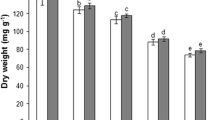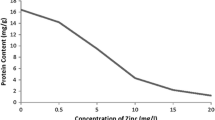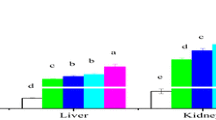Abstract
The effects of 5 μM cadmium (Cd), a non-essential toxic element and 25 and 50 μM zinc (Zn), an essential micronutrient, were investigated in aquatic plant Lemna minor L. after 4 and 7 days of exposure to each metal alone or to their combinations. Both metals showed tendency to accumulate with time, but when present in combination, they reduced uptake of each other. Cd treatment increased the lipid peroxidation and protein oxidation indicating appearance of oxidative stress. However, Zn supplementation in either concentration reduced values of both parameters, while exposure to Zn alone resulted in elevated level of lipid peroxidation and protein oxidation but only on the 7th day. Enhanced DNA damage, which was found on the 4th day in plants treated with Cd alone or in combination with Zn, was reduced on the 7th day in combined treatments. Higher catalase activity obtained in all treated plants on the 4th day of experiment was reduced in Zn-treated plants, but remained high in plants exposed to Cd alone or in combination with Zn after 7 days. Cd exposure resulted in higher peroxidase activity, while Zn addition prominently reduced peroxidase activity in the plants subjected to Cd stress. In conclusion, Cd induced more pronounced oxidative stress and DNA damage than Zn in applied concentrations. Combined treatments showed lower values of oxidative stress parameters—lipid peroxidation, protein oxidation and peroxidase activity as well as lower DNA damage, which indicates alleviating effect of Zn on oxidative stress in Cd-treated plants.




Similar content being viewed by others
References
Aebi M (1984) Catalase in vitro. Method Enzymol 105:121–126
Aravind P, Prasad MNV (2003) Zinc alleviates cadmium induced toxicity in Ceratophyllum demersum, a fresh water macrophyte. Plant Physiol Biochem 41:391–397
Aravind P, Prasad MNV (2005) Cadmium-zinc interactions in a hydroponic system using Ceratophyllum demersum L.: adaptive ecophysiology, biochemistry and molecular toxicology. Braz J Plant Physiol 17:3–20
Aravind P, Prasad MNV, Malec P, Waloszek A, Strzałka K (2009) Zinc protects Ceratophyllum demersum L. (free-floating hydrophyte) against reactive oxygen species induced by cadmium. J Trace Elem Med Biol 23:50–60
Arora A, Sairam RK, Srivastava GC (2002) Oxidative stress and antioxidative system in plants. Curr Sci 82:1227–1234
Bradford MM (1976) A rapid and sensitive method for the quantitation of microgram quantities of protein utilizing the principle of protein-dye binding. Anal Biochem 72:248–254
Bueno P, Piqueras A (2002) Effect of transition metals on stress, lipid peroxidation and antioxidant enzyme activities in tobacco cell cultures. Plant Growth Regul 36:161–167
Cakmak I (2000) Possible roles of zinc in protecting plant cells from damage by reactive oxygen species. New Phytol 146:185–205
Chance B, Maehly AC (1955) Assay of catalases and peroxidases. Method Enzymol 2:764–775
Chaoui A, Mazhoudi S, Ghorbal MH, El Ferjani E (1997) Cadmium and zinc induction of lipid peroxidation and effects on antioxidant enzyme activities in bean (Phaseolus vulgaris L.). Plant Sci 127:139–147
Cho U-H, Seo N-H (2005) Oxidative stress in Arabidopsis thaliana exposed to cadmium is due to hydrogen peroxide accumulation. Plant Sci 168:113–120
Cuypers A, Vangronsveld J, Clijsters H (2001) The redox status of plant cells (AsA and GSH) is sensitive to zinc imposed oxidative stress in roots and primary leaves of Phaseolus vulgaris. Plant Physiol Biochem 39:657–664
Das P, Samantaray S, Rout GR (1997) Studies on cadmium toxicity in plants: a review. Environ Pollut 98:29–36
Drost W, Matzke M, Backhaus T (2007) Heavy metal toxicity to Lemna minor: studies on the time dependence of growth inhibition and the recovery after exposure. Chemosphere 67:36–43
Gichner T, Patková Z, Száková J, Demnerová K (2004) Cadmium induces DNA damage in tobacco roots, but no DNA damage, somatic mutations or homologous recombination in tobacco leaves. Mutat Res 559:49–57
Gichner T, Patková Z, Száková J, Žnidar I, Mukherjee A (2008) DNA damage in potato plants induced by cadmium, ethyl methanesulphonate and γ-rays. Environ Exp Bot 62:113–119
Gratão PL, Monteiro CC, Antunes AM, Peres LEP, Azevedo RA (2008) Acquired tolerance of tomato (Lycopersicon esculentum cv. Micro-Tom) plants to cadmium-induced stress. Ann Appl Biol 153:321–333
Hassan MJ, Zhang G, Wu F, Wie K, Chen Z (2005) Zinc alleviates growth inhibition and oxidative stress caused by cadmium in rice. J Plant Nutr Soil Sci 168:255–261
Heath RL, Packer L (1968) Photoperoxidation in isolated chloroplasts. I. Kinetics and stoichiometry of fatty acid peroxidation. Arch Biochem Biophys 125:189–198
Hiraga S, Sasaki K, Ito H, Ohashi Y, Matsui H (2001) A large family of class III plant peroxidases. Plant Cell Physiol 42:462–468
Horvat T, Vidaković-Cifrek Ž, Oreščanin V, Tkalec M, Pevalek-Kozlina B (2007) Toxicity assessment of heavy metal mixtures by Lemna minor L. Sci Total Environ 384:229–238
Hossain Z, Huq F (2002) Studies on the interaction between Cd2+ ions and DNA. J Inorg Biochem 90:85–96
ISO - International Organization for Standardization (2006) Determination of the toxic effect of water constituents and wastewater on duckweed (Lemna minor)—Duckweed growth inhibition test. ISO norm 20079
Kawano T (2003) Role of the reactive oxygen species generating peroxidase reactions in plant defence and growth induction. Plant Cell Rep 21:829–837
Khellaf N, Zerdaoui M (2010) Growth response of the duckweed Lemna gibba L. to copper and nickel phytoaccumulation. Ecotoxicology 19:1363–1368
Kwan KHM, Smith S (1991) Some aspects of the kinetics of cadmium uptake by fronds of Lemna minor L. New Phytol 117:91–102
Laemmli UK (1970) Cleavage of structural proteins during the assembly of the head of bacteriophage T4. Nature 227:680–685
Levine RL, Williams JA, Stadtman ER, Shacter E (1994) Carbonyl assay for determination of oxidatively modified proteins. Method Enzymol 233:346–357
Lewis MA (1995) Use of freshwater plants for phytotoxicity testing: A review. Environ Pollut 87:319–336
Lin CW, Chang HB, Huang HJ (2005) Zinc induces mitogen-activated protein kinase activation by reactive oxygen species in rice roots. Plant Physiol Biochem 43:963–968
Lin A, Zhang X, Chen M, Cao Q (2007) Oxidative stress and DNA damages induced by cadmium accumulation. J Environ Sci 19:596–602
Mithöfer A, Schultze B, Boland W (2004) Biotic and heavy metal stress response in plants: evidence for common signals. FEBS Lett 566:1–5
Mittler R (2002) Oxidative stress, antioxidants and stress tolerance. Trends Plant Sci 7:405–410
Mohan BS, Hosetti BB (1997) Potential phytotoxicity of lead and cadmium to Lemna minor grown in sewage stabilization ponds. Environ Pollut 98:233–238
Muschitz A, Faugeron C, Morvan H (2009) Response of cultured tomato cells subjected to excess zinc: role of cell wall in zinc compartmentation. Acta Physiol Plant 31:1197–1204
Peraza MA, Fierro FA, Barber DS, Casarez E, Rael LT (1998) Effects of micronutrients on metal toxicity. Environ Health Persp 106:203–216
Pirson A, Seidel F (1950) Zell- und stoffwechselphysiologische Untersuchungen an der Wurzel von Lemna minor unter besonderer Berücksichtigung von Kalium- und Calciummangel [Cell metabolism and physiology in Lemna minor root deprived of potassium and calcium, in German]. Planta 38:431–473
Razinger J, Dermastia M, Dolenc Koce J, Zrimec A (2008) Oxidative stress in duckweed (Lemna minor L.) caused by short-term cadmium exposure. Environ Pollut 153:687–694
Rellán-Álvarez R, Ortega-Villasante C, Álvarez-Fernández A, Del Campo FF, Hernández LE (2006) Stress responses of Zea mays to cadmium and mercury. Plant Soil 279:41–50
Rout GR, Das P (2003) Effect of metal toxicity on plant growth and metabolism: I. Zinc. Agronomie 23:3–11
Sandalio LM, Dalurzo HC, Gómez M, Romero-Puertas MC, del Río LA (2001) Cadmium-induced changes in the growth and oxidative metabolism of pea plants. J Exp Bot 52:2115–2126
Shah K, Kumar RG, Verma S, Dubey RS (2001) Effect of cadmium on lipid peroxidation, superoxide anion generation and activities of antioxidant enzymes in growing rice seedlings. Plant Sci 161:1135–1144
Shaw BP, Sahu SK, Mishra RK (2004) Heavy metal induced oxidative damage in terrestrial plants. In: Prasad MNV (ed) Heavy metal stress in plants. From biomolecules to ecosystems. Springer, Berlin, Heidelberg, pp 84–126
Singh S, Eapen S, D’Souza SF (2006) Cadmium accumulation and its influence on lipid peroxidation and antioxidative system in an aquatic plant, Bacopa monnieri L. Chemosphere 62:233–246
Tkalec M, Prebeg T, Roje V, Pevalek-Kozlina B, Ljubešić N (2008) Cadmium-induced responses in duckweed Lemna minor L. Acta Physiol Plant 30:881–890
Tuteja N, Singh MB, Misra MK, Bhalla PL, Tuteja R (2001) Molecular mechanisms of DNA damage and repair: progress in plants. A review. Crit Rev Biochem Mol Biol 36:337–397
Ünyayar S, Celik A, Cekic OF, Gozel A (2006) Cadmium induced genotoxicity, cytotoxicity and lipid peroxidation in Allium sativum and Vicia faba. Mutagenesis 21:77–81
Vaillant N, Monnet F, Hitmi A, Sallanon H, Coudret A (2005) Comparative study of responses in four Datura species to a zinc stress. Chemosphere 59:1005–1013
Vallee BL, Falchuk KH (1993) The biochemical basis of zinc physiology. Physiol Rev 73:79–118
Valverde M, Trejo C, Rojas E (2001) Is the capacity of lead acetate and cadmium chloride to induce genotoxic damage due to direct DNA-metal interaction? Mutagenesis 16:265–270
Welch RM (1995) Micronutrient nutrition of plants. Crit Rev Plant Sci 14:49–82
Woodbury WA, Spencer K, Stahlmann MA (1971) An improved procedure using ferricyanide for detecting catalase isozymes. Anal Biochem 44:301–305
Wu F, Zhang G (2002) Alleviation of cadmium-toxicity by application of zinc and ascorbic acid in barley. J Plant Nutr 25:2745–2761
Źróbek-Sokolnik A, Asard H, Górska-Koplińska K, Górecki RJ (2009) Cadmium and zinc-mediated oxidative burst in tobacco BY-2 cell suspension cultures. Acta Physiol Plant 31:43–49
Acknowledgments
This work was supported by the Ministry of Science, Education and Sports of the Republic of Croatia, projects no. 119-1191196-1202 and 119-0982934-3110.
Author information
Authors and Affiliations
Corresponding author
Rights and permissions
About this article
Cite this article
Balen, B., Tkalec, M., Šikić, S. et al. Biochemical responses of Lemna minor experimentally exposed to cadmium and zinc. Ecotoxicology 20, 815–826 (2011). https://doi.org/10.1007/s10646-011-0633-1
Accepted:
Published:
Issue Date:
DOI: https://doi.org/10.1007/s10646-011-0633-1




